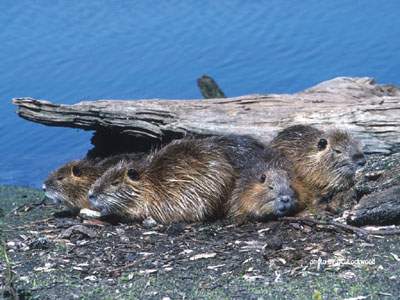Published in the Ocean Watch column, Honolulu Star-Advertiser © Susan Scott
October 26, 2009
LUFKIN, Texas » Last week during a visit to my friends’ cabin outside of Lufkin, Texas, the abundance of aquatic wildlife there surprised me. Since a great blue heron and two bald eagles perched a little too far away to see clearly, I decided to paddle a kayak around the lake. I wanted to see what other watery surprises this man-made lake held.
As I got ready, John said, “We have nutrias. Just so you know.”
Um, just so I know what? All I knew about nutrias was their name, which sounds more like a granola bar than an animal.
John explained these water animals look like beavers except they have ratlike tails. The species was imported from South America to the southern U.S. in the 1930s for its fur.
North Americans are the only ones who call this 12-pound animal a nutria. In most other places they’re known as coypu, the name given them by the Arucanians, an indigenous people of south-central Chile and Argentina, the animal’s native territory.
The term “nutria” comes from a Spanish/Latin word meaning otter and refers to coypu fur.
In their native lands, these furry creatures are an endangered species because people have destroyed most of the wetlands the animals need to survive. In the U.S., though, with demand for fashion fur way down, they’re pests.
(More irony: In Tierra del Fuego beavers imported from North America are their alien pests, destroying entire forests.)
Coypus resemble beavers but reproduce like rabbits, reaching sexual maturity in three to nine months. Females can produce three litters of three to 13 offspring per year. Because the female coypu’s milk glands are on her sides, the babies can nurse and breathe while Mom is in the water.

Like their close cousins the beavers and muskrats, coypus are strong-swimming air-breathers that live in burrows.
Today nutrias are so numerous in Louisiana and other coastal states rich in marshlands, they’re destroying their own habitat. This not only threatens native wildlife, but people, too. Healthy wetlands, marshes and swamps check flooding and runoff from storms.
The vegetarian coypus are particularly fond of shoots and roots, eating up the plants’ chances of future growth. In places where people are working to preserve and create wetlands, such grazing is a disaster.
The state of Louisiana has made valiant efforts to put their copious coypus to good use, promoting their lean meat as healthful and tasty. Unfortunately, no one is buying it and the coypus killed are wasted.
Hunters there get $5 per coypu tail. After shooting or catching one in a trap, they cut off the tail and then slit the animal’s belly to sink it, thus preventing avian scavengers from eating meat that might contain poisonous lead buckshot.
During my kayak trip around the small lake, I enjoyed the company of white herons, green dragonflies, brown shorebirds and carp so big their fins cut the water like little sails.
That Texas lake held another surprise for me, too. As I silently drifted around a corner of tall reeds, I startled a pair of nutrias half out of their luxurious skins, and the feeling was mutual.
But for just that second before the animals dived underwater, I got a brief look at their beaverlike bodies and long ratlike tails.
I was glad John told me they had nutrias. Just so I knew.